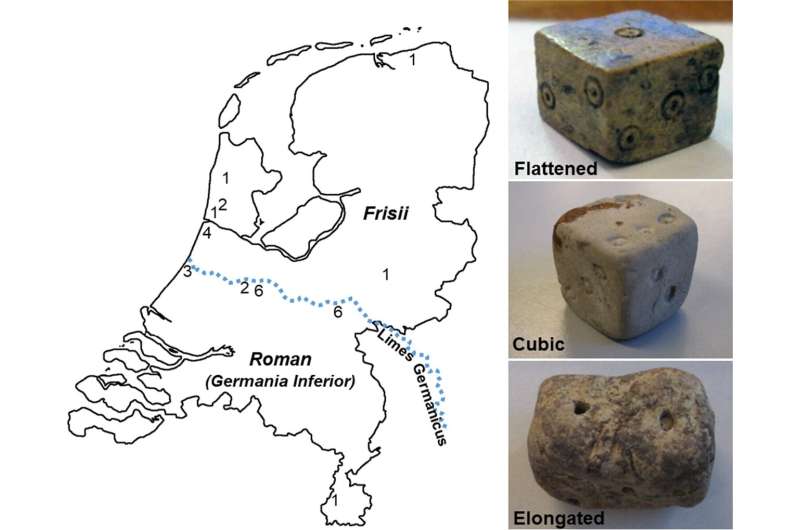Archaeological and Anthropological Sciences (2022). DOI: 10.1007/s12520-022-01599-y” width=”800″ height=”530″/>
Map of present-day Netherlands showing the location of the Roman sites included in this study (the number corresponds to the number of dice measured at each location), along with three examples of dice on the right. Credit: Archaeological and Anthropological Sciences (2022). DOI: 10.1007/s12520-022-01599-y
A pair of researchers, one with the University of California, Davis, and the other with Drew University, believe they have solved the mystery of why people living during the time of the Roman Empire used skewed dice in their games. In their article published in the magazine Archaeological and Anthropological SciencesJelmer Eerkens and Alex de Voogt, describe their study of dice that were used in the time of the Roman Empire.
In the days of the Roman Empire, people played a game called taberna (similar to backgammon), which involved throwing dice. The dice were made of bone, metal or clay and had symbols on the faces to represent numbers, much like modern dice. But they clearly differed in shape. The Roman dice were usually oblong or made in other odd shapes that made them asymmetrical.
In this new effort, the researchers studied 28 die from the period and found that 24 of them were asymmetrical. They found a pattern in the irregularity – pictographs representing one and six were often present on larger opposing surfaces. Prior research has shown that asymmetry in a die can affect the probability of a particular side-up landing. Based on their measurements, the researchers calculated that the difference in size would change the odds of rolling a given number on average from one in six to one in 2.4.
To find out whether the Romans made their dice asymmetrical to cheat, the researchers conducted an experiment: They asked 23 students to place markers on reproductions of the asymmetrical Roman dice. The researchers reasoned that because the students would not know the purpose of the experiment and have no reason to cheat, they would usually place the numbers randomly. But that was not the case, the students placed the one and six on the larger side. When asked why, many suggested it was easier because starting on a large side meant ending on a large side where they should put the most pips — a finding that suggests the Romans weren’t trying to cheat, they were just trying to make life easier for themselves. It also suggests that they weren’t too concerned about which face was assigned which number, as they believed that many random events, such as the rolling of dice, were determined by fate. But the researchers also note that, over time, smarter people likely found that certain dice rolls were more likely to yield a one or a six, and thus pick one or the other.
How to cheat with dice – from an expert in games
Jelmer W. Eerkens et al, Why are dice from the Roman period asymmetrical? An experimental and quantitative approach, Archaeological and Anthropological Sciences (2022). DOI: 10.1007/s12520-022-01599-y
© 2022 Science X Network
Quote: Why the early Romans used skewed dice (2022, August 5) retrieved August 6, 2022 from https://phys.org/news/2022-08-early-romans-lopsided-dice.html
This document is copyrighted. Other than fair dealing for personal study or research, nothing may be reproduced without written permission. The content is provided for informational purposes only.

